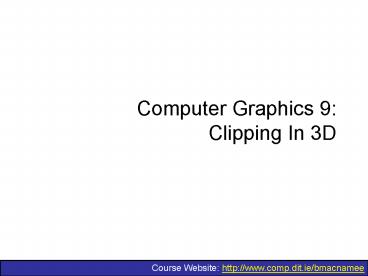Computer Graphics 9: Clipping In 3D - PowerPoint PPT Presentation
1 / 24
Title:
Computer Graphics 9: Clipping In 3D
Description:
Nate Robins' OpenGL tutorials. The clipping volume. The zone labelling ... Nate Robins has a number of great OpenGL tutorial applications posted on his website ... – PowerPoint PPT presentation
Number of Views:1547
Avg rating:3.0/5.0
Title: Computer Graphics 9: Clipping In 3D
1
Computer Graphics 9Clipping In 3D
2
Contents
- In todays lecture we are going to have a look at
some perspective view demos and investigate how
clipping works in 3-D - Nate Robins OpenGL tutorials
- The clipping volume
- The zone labelling scheme
- 3-D clipping
- Point clipping
- Line clipping
- Polygon clipping
3
Nate Robins OpenGL Tutorials
- Nate Robins has a number of great OpenGL tutorial
applications posted on his website
Nate Robins OpenGL Tutorials available at
http//www.xmission.com/nate/tutors.html
4
3-D Clipping
- Just like the case in two dimensions, clipping
removes objects that will not be visible from the
scene - The point of this is to remove computational
effort - 3-D clipping is achieved in two basic steps
- Discard objects that cant be viewed
- i.e. objects that are behind the camera, outside
the field of view, or too far away - Clip objects that intersect with any clipping
plane
5
Discard Objects
- Discarding objects that cannot possibly be seen
involves comparing an objects bounding box/sphere
against the dimensions of the view volume - Can be done before or after projection
6
Clipping Objects
- Objects that are partially within the viewing
volume need to be clipped just like the 2D case
7
The Clipping Volume
- After the perspective transformation is complete
the frustum shaped viewing volume has been
converted to a parallelopiped - remember we
preserved all z coordinate depth information
8
Normalisation
- The transformed volume is then normalised around
position (0, 0, 0) and the z axis is reversed
9
When Do We Clip?
- We perform clipping after the projection
transformation and normalisation are complete - So, we have the following
- We apply all clipping to these homogeneous
coordinates
10
Dividing Up The World
- Similar to the case in two dimensions, we divide
the world into regions - This time we use a 6-bit region code to give us
27 different region codes - The bits in these regions codes are as follows
11
Dividing Up The World (cont..)
- Because we have a normalised clipping volume we
can test for these regions as follows - Rearranging these we get
12
Region Codes
13
Point Clipping
- Point clipping is trivial so we wont spend any
time on it
14
Line Clipping
- To clip lines we first label all end points with
the appropriate region codes - We can trivially accept all lines with both
end-points in the 000000 region - We can trivially reject all lines whose end
points share a common bit in any position - This is just like the 2 dimensional case as these
lines can never cross the viewing volume - In the example that follows the line from
P3010101 to P4100110 can be rejected
15
Line Clipping Example
16
The Equation Of The Line For 3D Clipping
- For clipping equations for three dimensional line
segments are given in their parametric form - For a line segment with end points P1(x1h, y1h,
z1h, h1) and P2(x2h, y2h, z2h, h2) the parametric
equation describing any point on the line is
17
The Equation Of The Line For 3D Clipping (cont)
- From this parametric equation of a line we can
generate the equations for the homogeneous
coordinates
18
3D Line Clipping Example
- Consider the line P1000010 to P2001001
- Because the lines have different values in bit 2
we know the line crosses the right boundary
19
3D Line Clipping Example (cont)
- Since the right boundary is at x 1 we now know
the following holds - which we can solve for u as follows
- using this value for u we can then solve for yp
and zp similarly
20
3D Line Clipping Example (cont)
- When then simply continue as per the two
dimensional line clipping algorithm
21
3D Polygon Clipping
- However the most common case in 3D clipping is
that we are clipping graphics objects made up of
polygons
22
3D Polygon Clipping (cont)
- In this case we first try to eliminate the entire
object using its bounding volume - Next we perform clipping on the individual
polygons using the Sutherland-Hodgman algorithm
we studied previously
23
Cheating with Clipping Planes
- For far clipping plane introduce something to
obscure far away objects fog - Make objects very near the camera transparent
24
Summary
- In todays lecture we examined how clipping is
achieved in 3-D































